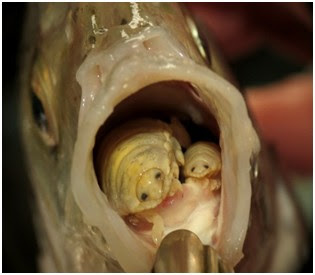Cymothoa exigua or the tongue eating louse may be most dangerous parasite in the world that scientist has ever discovered. It is a parasitic isopod of the family Cymothoidae. These parasites are most often found inhabiting the mouths of their fish hosts, effectively replacing the fishes’ tongues, which is how these parasites got their nickname ‘tongue eating louse’. This parasite enters fish through their gills. The female parasite attaches to the tongue and the male parasite attaches on the gill arches beneath and behind the female. The parasite severs the blood vessels in the fish’s tongue, causing the tongue to fall off. Males are approximately 7.5-15mm long and females are 8-29 mm long. These parasites were first found, inside the tongue of fishes that caught in a fishing net by a Brazilian fisherman. Each of those fishes had not tongue.
Cymothoa exigua enters any kind of fish though their gills, then spreads its claws and settles in the host’s tongue and it causing the tongue to atrophy from of blood. Then parasite replaces the fish’s tongue by attaching its own body to the muscles of the tongue stub. The now tongue-less fish starts using its new mouth isopod as a replacement tongue, while the parasitic “tongue” continues to feed on its host’s blood and mucus. You believe it or not, the fish can survive and get by just fine with a parasite as a tongue. But this poor host fish cannot open their mouth and let the louse walk or swim in, so you might be might be wondering how these parasites get to their ultimate oral destination. They enter through the gills! Often, multiple tongue eating lice enter the same host, but only of them will have the privilege of replacing its tongue. So how do they decide? Only the female parasites do it. Replacing tongues just isn’t weird enough in the parasite world; but C. exigua are also protoandric hermaphrodites, meaning each individual is born male and can become female later in life. If no female is already present, all C. exigua individuals that enter through the gills are male then transforms into the female. The female then makes its way to the fish’s mouth where it uses its front claws to attach to the fish’s tongue and the remaining unattached males may stay and live in the fish’s gills chambers. When a host fish dies, C. exigua will detach itself from the tongue stub after some time, leave the fish’s mouth cavity and can then be seen clinging to its head or body externally.
It is currently believed that C. exigua are not harmful to humans, except that they will bite if separated from their host and handled. However, they can be a nuisance to humans because they parasitize commercial fish around the world. A lawsuit against a supermarket in Puerto Rico emerged after someone claimed they were poisoned from an isopod inside a cooked fish, but since these isopods are not toxic to humans, the lawsuit was unsuccessful.
Written by : S.A.P.M.Bandara
References:
https://www.google.com/amp/s/theethogram.com/2020/04/14/creature-feature-tongue-eating-louse/amp/?espv=1
https://en.m.wikipedia.org/wiki/Cymothoa_exigua















